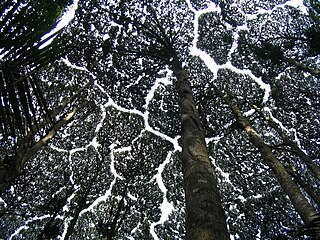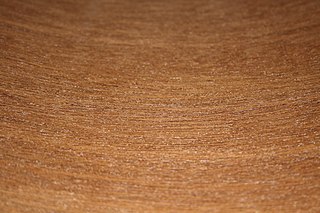
Resveratrol (3,5,4′-trihydroxy-trans-stilbene) is a stilbenoid, a type of natural phenol, and a phytoalexin produced by several plants in response to injury or when the plant is under attack by pathogens, such as bacteria or fungi. Sources of resveratrol in food include the skin of grapes, blueberries, raspberries, mulberries, and peanuts.

Banksia robur, commonly known as swamp banksia, grows in sand or peaty sand in coastal areas from Cooktown in north Queensland to the Illawarra region on the New South Wales south coast. It is often found in areas which are seasonally inundated.

Banksia oblongifolia, commonly known as the fern-leaved, dwarf or rusty banksia, is a species in the plant genus Banksia. Found along the eastern coast of Australia from Wollongong, New South Wales in the south to Rockhampton, Queensland in the north, it generally grows in sandy soils in heath, open forest or swamp margins and wet areas. A many-stemmed shrub up to 3 m (9.8 ft) high, it has leathery serrated leaves and rusty-coloured new growth. The yellow flower spikes, known as inflorescences, most commonly appear in autumn and early winter. Up to 80 follicles, or seed pods, develop on the spikes after flowering. Banksia oblongifolia resprouts from its woody lignotuber after bushfires, and the seed pods open and release seed when burnt, the seed germinating and growing on burnt ground. Some plants grow between fires from seed shed spontaneously.

Banksia paludosa, commonly known as the marsh or swamp banksia, is a species of shrub in the plant genus Banksia. It is native to New South Wales, Australia, where it is found between Sydney and Batemans Bay, with an isolated population further south around Eden. There are two recognised subspecies, the nominate of which is a spreading shrub to 1.5 m (4.9 ft) in height, and subsp. astrolux is a taller shrub to 5 m (16 ft) high found only in Nattai National Park.

Banksia plagiocarpa, commonly known as Dallachy's blue banksia, blue banksia or Hichinbrook banksia, is a species of shrub or tree in the plant genus Banksia. It occurs only on Hinchinbrook Island, Queensland and the immediately adjacent mainland. First collected in 1867, Banksia plagiocarpa was not described until 1981, when Alex George named it in his monograph of the genus Banksia. Genetic studies show it to be related to Banksia aquilonia, Banksia oblongifolia and Banksia robur.

Dryobalanops aromatica, commonly known as Borneo camphor, camphor tree, Malay camphor, or Sumatran camphor, is a species of plant in the family Dipterocarpaceae. The species name aromatica is derived from Latin and refers to the smell of the dammar (resin). This species was one of the main sources of camphor and attracted early Arab traders to Borneo, at that time being worth more than gold, and used for incense and perfumes.
Dryobalanops oblongifolia is a species of plant in the family Dipterocarpaceae, native to regions of Southeast Asia and Maritime Southeast Asia.

Breynia oblongifolia, commonly known as coffee bush, grows naturally in Australia and New Guinea as shrubs up to 3 m (10 ft) in height. The species produces alternate, distichous, ovate leaves 20–30 mm (0.8–1.2 in) long by 10–20 mm (0.4–0.8 in) wide. Small, green flowers are produced in spring and summer, and these are followed by orange or pink berries about 6 mm (0.24 in) diameter that turn black when fully ripe.

ε-Viniferin is a naturally occurring phenol, belonging to the stilbenoids family. It is a resveratrol dimer.

α-Viniferin is a stilbene trimer. It can be isolated from Caragana chamlagu and from Caragana sinica and from the stem bark of Dryobalanops aromatica. It is also present in relation to resistance to Botrytis cinerea and Plasmopara viticola in Vitis vinifera and Vitis riparia. It has been shown to inhibit acetylcholinesterase.
The molecular formula C42H32O9 (molar mass: 680.69 g/mol, exact mass: 680.204633 u) may refer to:

Diptoindonesin A is a C-glucoside of ε-viniferin isolated from the two Dipterocarpaceae Shorea seminis and Dryobalanops aromatica.

Kapur is a dipterocarp hardwood from trees of the genus Dryobalanops found in lowland tropical rainforests of Malaysia, Indonesia and South-East Asia. It is a durable construction tropical timber. One variety, D. aromatica, is a source of camphor.

Quercus oblongifolia, commonly known as the Mexican blue oak, Arizona blue oak, Blue live oak or Sonoran blue oak, is an evergreen small tree or large shrub in the white oak group.

Oligostilbenoids are oligomeric forms of stilbenoids. Some molecules are large enough to be considered polyphenols and constitute a class of tannins.

Brickellia oblongifolia, the Mojave brickellbush, is North American species of plants in the family Asteraceae. It is widespread across arid and semi-arid regions in the western United States and Canada, from British Columbia south to southern California, Arizona, and New Mexico.

Crown shyness is a feature observed in some tree species, in which the crowns of fully stocked trees do not touch each other, instead forming a canopy with channel-like gaps. This is most prevalent among trees of the same species, but also occurs between trees of different species. There exist many hypotheses as to why crown shyness is an adaptive behavior, and research suggests that it might inhibit spread of leaf-eating insect larvae.
Binsuluk Forest Reserve is a protected forest reserve on the Klias Peninsula, in Beaufort District of Interior Division, Sabah, Malaysia. It was designated as a Class 1 Protection Forest by the Sabah Forestry Department in 1992. Its area is 12,106 hectares (121.06 km2). The reserve is mostly flat, consisting mostly of peat swamp forest, with a small area of mangroves. The peat forests within this reserve, along with those in the nearby Klias Forest Reserve, are the last peat forests in Sabah.
Xylosandrus mancus, is a species of weevil found in Afrotropical and Oriental regions.
Arixyleborus malayensis, is a species of weevil found in India, Sri Lanka, China, Japan, Malaysia, Vietnam and Indonesia. This is the only species of Arixyleborus found in Japan and China.














